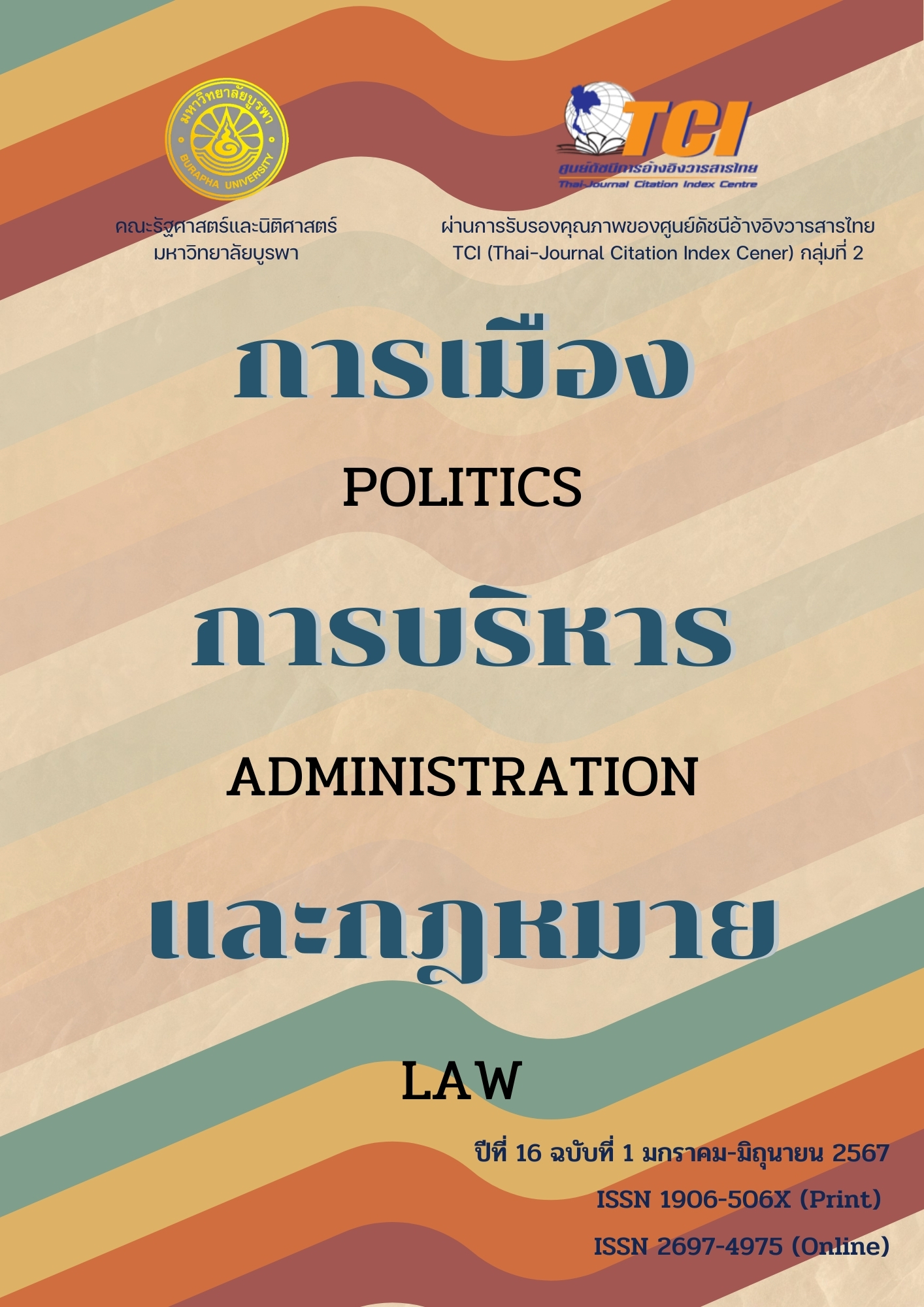The Development of Tourism Routes in the Old Town Community along the Phetchaburi River Focusing on Historical and Cultural Tourism in order to Enhance Phetchaburi Province into a Creative City
Keywords:
Tourism Program, Historical and Cultural Tourism, Creative CityAbstract
This research aims to study the opinions and potentials of community regarding the improvement of tourism routes in the old town community area along the Phetchaburi River and to develop tourism routes in the old town community area along the Phetchaburi River by using qualitative research method. This involved area-based research and in-depth interviews with community leaders and residents living in the area. The research findings reveal several outstanding aspects, particularly its status as a city rich in historical and cultural heritage, maintaining authentic and original features. This is evident from the number of ancient temples that can be traced back to historical periods, such as Wat Kamphaeng Laeng from the Lopburi period, Wat Yai Suwannaram, Wat Ko, and Wat Khao Bandai It, which are exemplary of the temples from the Ayutthaya Kingdom period. As the city transitioned into the Rattanakosin period, the city of Phetchaburi is even outstanding as a city with two royal palaces, Phra Nakhon Khiri and Phra Ram Ratchaniwet, highlighting Phetchaburi's historical importance closely linked to the Chakri dynasty. Additionally, the city possesses ancient communities with sufficient potential for development to accommodate tourists. In the past, a number of tourists have visited various temples and palaces in Phetchaburi to engage in religious practices and admire the beauty of ancient craftsmanship. However, the number of visitors to these cultural heritage sites remains low compared to the influx of tourists to other districts known for their natural attractions. Therefore, to enhance the appeal of Phetchaburi and promote it as a destination rich in historical and cultural heritage, the research team has undertaken several initiatives. These include organizing a seminar entitled "Phetch City: A Gem of Historical and Cultural Tourism," which was broadcasted via Facebook to disseminate the city’s cultural value to the public. Additionally, the researchers conducted field surveys of historical and cultural sites to create an E-BOOK for public distribution and also developed a tourism program for the old community areas along the Phetchaburi River, focusing on historical and cultural tourism, with the goal of elevating Phetchaburi into a creative city.
References
ชาย โพธิสิตา. (2562). ศาสตร์และศิลป์การวิจัยเชิงคุณภาพ (พิมพ์ครั้งที่ 8). กรุงเทพฯ: สถาบันวิจัยประชากรและสังคม มหาวิทยาลัยมหิดล.
ใบเฟิร์น วงษ์บัวงาม และญาณาธร เธียรถาวร. (2566). การมีส่วนร่วมของชุมชนในการจัดการและการพัฒนาการท่องเที่ยวเชิงสร้างสรรค์ เพื่อนำไปสู่การเป็นเมืองสร้างสรรค์ จังหวัดเพชรบุรี. วิทยาการจัดการวไลยอลงกรณ์ปริทัศน์, 4(3), 45-61.
ประสพชัย พสุนนท์ และคณะ. (2564). การพัฒนาชุมชนต้นแบบด้วยการท่องเที่ยวเชิงสร้างสรรค์และยั่งยืน เพื่อยกระดับจังหวัดเพชรบุรีสู่เมืองสร้างสรรค์. กรุงเทพฯ: สำนักงานการวิจัยแห่งชาติ.
วันเพ็ญ มังศรี. (2565). เพชรบุรีเครือข่ายเมืองสร้างสรรค์ของยูเนสโก. รัฎฐาภิรักษ์, 64(1), 85-99.
วิชชาญ จุลหริก. (2566). การพัฒนารูปแบบอาหารท้องถิ่นในเส้นทางการท่องเที่ยวเชิงสร้างสรรค์สู่การเป็นเมืองพักผ่อนเพื่อสุขภาพชั้นนำในเขตพัฒนาการท่องเที่ยวอำเภอเมือง จังหวัดสงขลา. วารสารวิชาการและวิจัย มหาวิทยาลัยภาคตะวันออกเฉียงเหนือ, 13(1), 154-167.
สำนักงานจังหวัดเพชรบุรี. (2566). แผนพัฒนาจังหวัดเพชรบุรี พ.ศ. 2566-2567. (ฉบับทบทวน ประจำปีงบประมาณ พ.ศ. 2568). เพชรบุรี: สำนักงานจังหวัดเพชรบุรี.
อธิป จันทร์สุริย์, สุดสันต์ สุทธิพิศาล และขวัญณภัทร ขนอนคราม. (2563). แนวทางการพัฒนาการท่องเที่ยวเชิงสร้างสรรค์บนฐานอัตลักษณ์ ความเป็นไทยตลาดไทยย้อนยุคบ้านระจัน จังหวัดสิงห์บุรี. ทีทัศน์วัฒนธรรม สำนักศิลปะและวัฒนธรรม มหาวิทยาลัยราชภัฏบ้านสมเด็จเจ้าพระยา, 19(2),141-162.
Binkhorst, E. (2006). The Co–Creation Tourism Experience. Retrieved December 20, 2022, from http://www.esade.edu/cedit2006/pdfs2006/papers/esther_binkhorst_paper_esade_may_06.pdf
Creswell, J. W. (1998). Qualitative inquiry and research design; Choosing among five traditions. Thousand Oaks, CA; Sage Publications.
Goeldner, C., & Ritchie, J. R. B. (2006). Tourism: principles, practices, philosophies (10th ed.). Hoboken: Wiley.
Hollowitz, J., & Wilson, C. E. (1993). Structured Interviewing in Volunteer Selection. Journal of Applied Communication Research, 21, 41-52.
Jamshed, S. (2014). Qualitative Research Method-interviewing and Observation. Journal of Basic and Clininal Pharmacy, 5(4), 87-88.
Richards, G., & Raymond, C. (2000). Creative Tourism. ATLAS News, 23, 16-20.
UNESCO. (2 0 0 6 ). Towards Sustainable Strategies for Creative Tourism Discussion Report of the Planning Meeting for 2 0 0 8 International Conference on Creative Tourism. New Mexico, USA.: Santa Fe.
Wurzburger, R., & et al. (2009). Creative Tourism: A Global Conversation: How to Provide Unique Creative Experiences for Travelers Worldwide. As Presented at the 2008 Santa Fe & UNESCO International Conference on Creative Tourism in Santa Fe. New Mexico, USA. Santa Fe: Sunstone Press.]
Downloads
Published
Issue
Section
License

This work is licensed under a Creative Commons Attribution-NonCommercial-NoDerivatives 4.0 International License.






